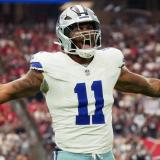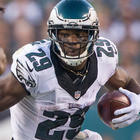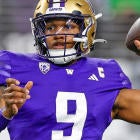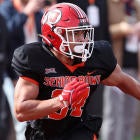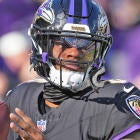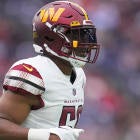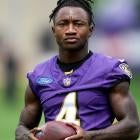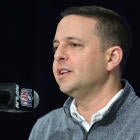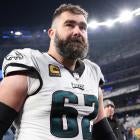Sometimes, especially in the dog days of the endless NFL offseason, I like to have fun with numbers.
Armed with an account to the STATS, Inc., database, and with several hours on my hands, I started playing around with some of the more esoteric stats and search functions and seeing what caught my eye.
In several cases the numbers seem to point to a potential ascent, or descent, for particular players. In others, well, I'm not positive precisely what to infer from the numerical data, but found the stats interesting nonetheless. And I realize that not every numeral can be interpreted as the full story on a player or subject.
I was actually somewhat focusing on running backs to start, because so much of what happens at that position seems somewhat random and/or so thoroughly dictated by health. It doesn't even seem to strike us as odd anymore that a guy like DeMarco Murray can go from a borderline historically significant season like the one he had in Dallas (in 2014), to a guy whose coach barely wants him on the field the following year, despite paying him a boatload of money to join his roster.

Seems we can pretty much bank on every year someone going from total obscurity (Priest Holmes, Arian Foster, Justin Forsett, Terrell Davis, are a few guys who come to mind) into some of the league's premier rushers -- at least for a season -- and then, just as quickly, they tend to not fade away as much as just become extinct. Guys like Shaun Alexander, Marshawn Lynch and Clinton Portis went from flirting with 1,500-yard seasons to out of the league and/or unable to get a workout in like 18 months time.
It is a brutally demanding position and when guys hit the wall, they do so abruptly.
I also tended to focus on what the numbers indicated on some of the rising young passers in the NFL, as well, and threw in a few team stats as well that caught my eye.
I'm a bigger Derek Carr guy than I am Blake Bortles, but both could use more help from their pass catchers. Plenty is made about some of the uber-talented young receivers around them, but dropped passes have been major issues for Oakland and Jacksonville despite the high praise.
Last season eight percent of Carr's attempts were deemed dropped passes on catchable balls. Of all regular starting quarterbacks in the league, only Sam Bradford had a higher percentage of those passes dropped (8.7 percent).
Bortles was right there with Carr, at 7.8 percent. In 2014, only Andrew Luck (8.9 percent) had a larger percentage of catchable passes dropped than Bortles (8.8 percent), and Carr was right there with them again (8.2 percent).
If the backs, tight ends and receivers can cut that number down closer to the league average -- roughly 5 percent -- then obviously we'll see even more increased production from these emerging quarterbacks.
Another reason to be bullish on Bortles, if you are inclined to lean that way. Last year Allen Robinson caught 12 red zone TDs, more than anyone in the NFL. And the Jags didn't have the full services of a healthy Julius Thomas most of the season due to injuries.
In 2014, Thomas had nine red zone TD catches, tied for second in the NFL (playing with Peyton Manning, of course, but still worth noting). Having those two red zone threats on the field together should further unlock that offense and aid the QB's development in this critical area of the field (he took six red zone sacks last year, tied for second-most in the NFL).
There are several reasons why I believe Jared Goff will be in for a lot of pain -- physical pain -- this season, with much of it focused on the offensive line. In addition to all the sacks the Rams surrender, it's worth pointing out that tackle Greg Robinson led the league with 11 holding penalties last season (he had more holding penalties accepted on him than anyone else in the NFL surrendered in total in 2015).
Like many of you -- dare I say, most of you -- I knew pretty much nothing about Thomas Rawls prior to his shocking emergence for the Seahawks last year. He ran for more than 800 yards and re-energized Seattle's run game despite not reaching even 150 carries. A staggering 15 percent of his carries went for 10 yards or more, far and away tops in the NFL.
Not sure is that will prove to be an anomaly or not, but Marshawn Lynch went 10 yards or more on 11.7 percent of his 111 carries for the Seahawks last season. If Rawls can maintain close to that percentage of explosive runs for the Seahawks, they'll be deep in the postseason again.
I like Mike Evans to take a major step up this season. He's suffered from drops and immaturity, but his quarterback -- Jameis Winston -- is only going to advance in leaps and bounds.
Winston loves feeding Evans, even when he was slumping early last season. Evans was targeted 10 times a game last season -- eighth in the NFL -- yet had only three touchdown catches. I suspect he triples that touchdown total in 2016.
The Colts had better have the next great come-out-of-nowhere running back on their roster, because I'm finally betting against Frank Gore. Yes, he still finished in the NFL's top 10 in rushing last season, but he averaged just 3.7 yards per carry and reached 85 yards in a game just three times, and just once in the final 11 contests.
Reason No. $10M why Ryan Fitzpatrick should come back to the Jets: He was sacked on just 3.27 percent of his dropbacks in 2015, best in the NFL.
And if Ryan Clady stays healthy, the team probably upgraded its left tackle situation. You'll find any quarterback in the NFL who would sign up for that percentage of sacks-per-dropback right now for 2016.
And reason No. $25M why the Titans continue to focus on running backs and offensive linemen: Marcus Martiota was sacked on an NFL-high 9.31 percent of his dropbacks in 2015.
The beating he took cost Ken Whisenhunt his job early in the season, and everyone in that organization knows ownership is focused on keeping Mariota fully healthy. Anything close to a repeat of this percentage next year and Mariota will end up on IR.
Winston, by comparison, was sacked on 4.89 percent of his dropbacks, which is close to the league average.
People tend to discount Le'Veon Bell a bit, I believe, and especially perhaps now after DeAngelo Williams ran so well with him hurt last year. Bell, to me, may be the most complete back in the NFL, and he shifts the field like few others can.
Despite rushing just 113 times last year, Bell ranked among the very top of the NFL in 20-yard carries (Doug Martin was tops with 14). Bell took 7 percent of his carries for 20 yards more. Martin and Todd Gurley were at around 4.8 percent of their carries going that length.
Pittsburgh's line is legit and that offense was beastly enough without Bell, but I believe it will hit yet another level in 2016 if he is anything close to where he was before he got hurt.
I'm flirting with them as a Super Bowl pick.
First-down sacks are something that have long intrigued me. They're such a drive-killer and get teams woefully off track. Another reason why I wonder about the Adam Gase/Ryan Tannehill coupling -- the QB tied Drew Brees with 18 first-down sacks suffered last year.
Obviously, that's not all on the passer, but those two were sacked at twice the NFL on first down.
I was a big Marcus Peters guy since the summer, and will pat myself on the back for tabbing him early on as NFL Defensive Rookie of the Year. He is a dynamic game-changer and had five interception returns of 20 yards or more in 2015, by far tops in the NFL. He also scored on two of them.
Since 2000, here are the men who have had five or more interception returns of that length. (Hint: There aren't many, and those who did it were truly special):
- 2012: Stevie Brown -- 7
- 2009: Darren Sharper -- 7; Charles Woodson -- 5
- 2008: Nick Collins -- 6
- 2007: Ed Reed -- 5
- 2004: Ed Reed -- 6
- 2002: Ed Reed -- 5
- 2001: Brock Marion -- 5
I believe Russell Wilson and Cam Newton will end up having a helluva rivalry with many more playoff meetings coming between them. Renewing again in 2016.
Over the past three years, the Seahawks are an NFL-best 27-9 within the NFC, and the Panthers are 26-10. Arizona is third at 24-12.
I expect more of the season this season, and the road to the Super Bowl going through the winner of a Panthers-Seahawks tilt in January.































